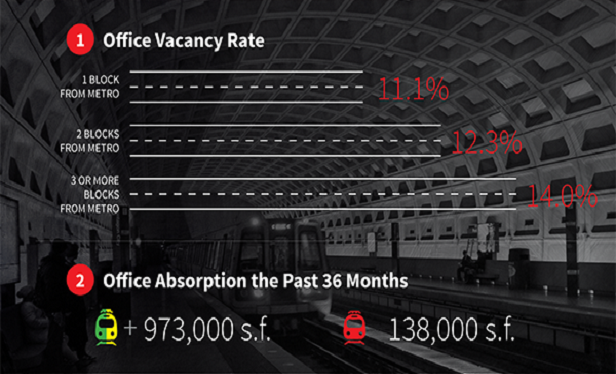WASHINGTON, DC—Office buildings in close proximity to the Metro have always had higher rents and occupancy than buildings farther from Metro. However the price gap between offices close to metro stops and those further out have narrowed in recent years as ridesharing has become more prominent, according to a new research note by JLL.
It found that the average asking rent at buildings located one block from a Metro stop is now $53.34 per square foot full-service. Buildings that are located two blocks from the Metro are priced at a 1.5% discount and buildings that are three blocks or more are priced at a 2.7% discount to the second set.
Ridesharing, though, has caused this price gap to narrow from the average 5.5% difference per increased block that was maintained between 2010-2016 into the smaller percentages seen today, JLL says.
It is unlikely that this gap will completely close as proximity to a metro stop is an important driver of rents and occupancy. There are 40 Metro stations in the city, but only 26% of office supply is located within one block of a station entrance, according to JLL.
Also, its research note also reports that proximity to specific Metro lines increasingly matters as the city's demographic patterns continue to shift eastward. Report author Elizabeth Curtis writes that “Over the past 36 months, office buildings located along the Yellow and Green Lines have outperformed office product located along the Red Line. Buildings located along the Green and Yellow Line's have recorded 1.0 million square feet of occupancy gains and availability has declined by 4%. In contrast, buildings along the Red Line have lost 138,000 square feet of occupancy and availability has increased by 69%.”
Curtis concludes by predicting that the dual impact of millennials living in the city rather than the inner urban Suburbs, coupled with that population's growing preference for ridesharing, may further soften the historical performance differentiation in Washington, DC ahead.
© Touchpoint Markets, All Rights Reserved. Request academic re-use from www.copyright.com. All other uses, submit a request to [email protected]. For more inforrmation visit Asset & Logo Licensing.








